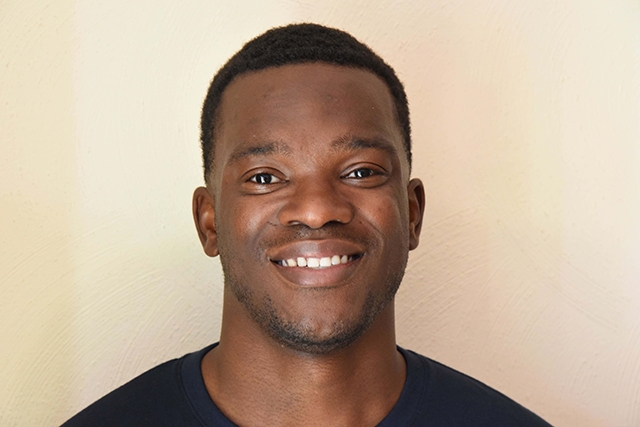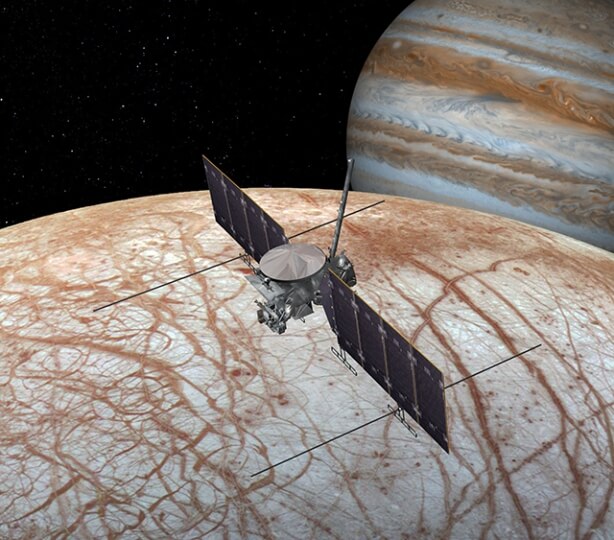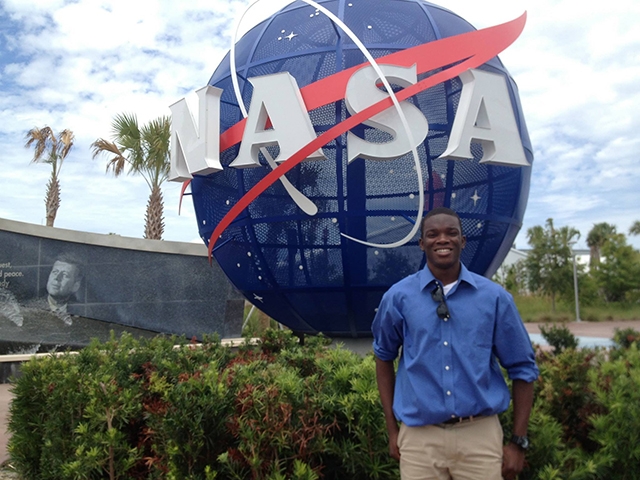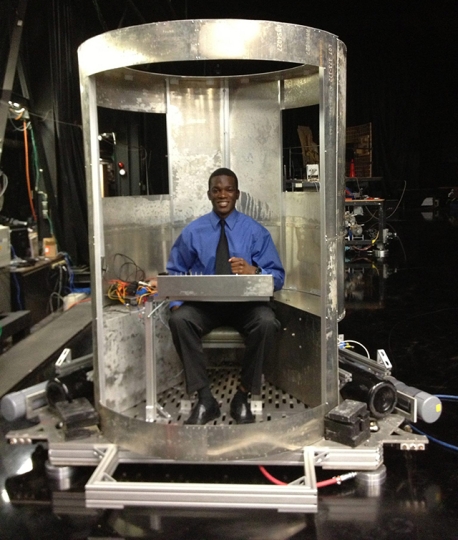Tunde Demuren, S.B. '15, a mechanical engineering concentrator, works as a systems engineer at the NASA Jet Propulsion Laboratory. (Photo courtesy of Tunde Demuren)
When he was a high school junior, Tunde Demuren spent a week at the NASA Langley Research Center planning a simulated mission to Mars.
Ten years later, Demuren is planning another NASA mission—for real this time.
As a systems engineer at the NASA Jet Propulsion Laboratory, he is working in the mission planning group for the Europa Clipper, a spacecraft that will perform a detailed investigation of Europa, one of the 79 moons of Jupiter.
“Europa has a layer of water underneath the ice surface, so that could lend itself to potentially supporting life,” said Demuren, S.B. ’15, a mechanical engineering concentrator at the Harvard John A. Paulson School of Engineering and Applied Sciences. “The mission is going to perform a number of flybys of Europa and use various instruments to perform studies on its composition.”
This artist's rendering shows NASA's Europa Clipper spacecraft. (Photo courtesy of NASA/JPL-Caltech)
For instance, an ice-penetrating radar will measure the thickness of the moon’s icy shell and a thermal instrument will look for evidence of recent eruptions of warmer water near the moon’s surface.
Demuren uses a NASA mission simulator to plan and evaluate the necessary activities the spacecraft will perform during its multi-year mission.
He uses the software to model specific maneuvers in deep space and within Jupiter’s orbit, and then monitors how those moves affect the critical resources of the spacecraft, like the power and thermal systems.
“One challenge is figuring out how to best go about modeling an activity that hasn’t been done before,” he said. “That requires connecting with a lot of different people and experts in different fields. That challenge of getting familiar with things that are so new to me is very exciting.”
For Demuren, the mystique of space exploration piqued his curiosity from a young age.
“I was fascinated by all the potential discovery that is available through space exploration,” he said. “It felt like it was a field that would never get stale. There are always new things to discover. And the skills you need to work in the field would be things that would challenge me and motivate me.”
Demuren at Kennedy Space Center, which he visited during a NASA internship. (Photo courtesy of Tunde Demuren)
He was introduced to engineering by his father, an engineering professor at Old Dominion University, and gravitated toward the field while attending a math and science high school. At Harvard, Demuren sought out ways to apply his mechanical engineering training in the aerospace realm.
He spent two summers interning at the NASA Marshall Space Flight Center in Huntsville, Ala., where he worked to develop a manned spacecraft concept vehicle and served as operations manager for the NASA Robotics Academy.
“During one of those internships, I got to visit JPL and I was blown away,” he said. “I’ve heard of the work they’ve done in terms of the Mars Rover, but being at the facility and seeing the mission control center and all the different deep space projects they work on made me think that’s the place I wanted to go.”
Demuren sits in the concept vehicle he and his teammates built during a NASA internship. (Photo courtesy of Tunde Demuren)
A NASA career was fixed on his radar.
After graduation, Demuren worked for Temple Allen Industries, a firm that manufactures aircraft equipment. He and his colleagues developed a manufacturing co-robot that had some autonomous processes but was also heavily controlled by an operator.
While he enjoyed the hands-on work, he continued to feel the tug of a career in space exploration. So Demuren enrolled in Stanford University where he earned a master’s degree in aerospace, aeronautical, and astronautical engineering. An internship at Capella Space in San Francisco, where he simulated spacecraft operations for the startup’s earth imaging satellites, gave him the boost he needed to land at NASA.
“It helped validate to myself that I could handle the field. Coming from a purely mechanical background, there is a little uncertainty about making the transition to aerospace because you need to bring a lot of broader skills. You need software experience and hardware experience,” he said. “Actually being productive in the industry, and at a startup where every person is critical to the work, was very self-affirming for me.”
At JPL, Demuren applies those broad skills as he works to model critical elements of the spacecraft’s operations.
Planning for a deep space mission presents a host of unique challenges. For instance, Europa is surrounded by radiation that is trapped in Jupiter’s magnetic field, which requires a delicate balancing act to protect the spacecraft from that radiation while ensuring the scientific instruments can successfully record measurements.
The mission is slated for a 2024 launch, and Demuren and his colleagues still have many hurdles to overcome before liftoff. But his fascination with space exploration and discovery keeps him motivated.
“It is exciting to know that when the spacecraft does blast off towards Jupiter, I’ll have played a role in getting it to that point,” he said. “I really like the big picture aspect of it and having my hands on so many different parts of this mission.”
Press Contact
Adam Zewe | 617-496-5878 | azewe@seas.harvard.edu



